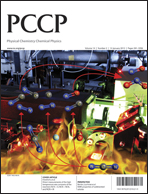Monte Carlo simulations have been performed for characterizing the 0.22 and 1 molar aqueous dimethylammonium chloride solutions at p = 1 atm and T = 310 K. On the basis of potential of mean force curves for the two systems with increasing concentrations, the N⋯N separations of about 8.7 and 7.5 Å correspond to a vague and a more pronounced minimum, respectively. Nitrogen separations at the minima are considerably smaller than those what the cations would take if the solutes comprised uniform local solute density on a microscale. The derived N by N coordination numbers predict non-negligible cation association and concomitant inhomogeneity for the studied systems. The calculated N⋯N distance distribution in the molar solution indicates that about 12% of the N⋯N separations are shorter than 8.5 Å compared with R(N⋯N) = 11.84 Å corresponding to the closest distance in a uniform cation local density. Despite a global minimum of −1.79 ± 0.63 kcal mol−1 at N⋯Cl separation of 3.24 Å, obtained from the pmf for the 0.22 molar model, the N by Cl coordination number is only 0.14 in the first coordination shell, suggesting frequent disruption of an N–H+⋯Cl+hydrogen bond in a relatively dilute solution. The expression for the chemical potential of a solute includes a concentration-dependent activity coefficient, whose varying values are expected to reflect the different degrees of solute association in the 0.2–1 molar range. Theoretical follow-up of the changes in the activity coefficient values is difficult, thus calculation of the Kc equilibrium constant has been proposed by considering 1 molar solutions as the standard state.

You have access to this article
 Please wait while we load your content...
Something went wrong. Try again?
Please wait while we load your content...
Something went wrong. Try again?


 Please wait while we load your content...
Please wait while we load your content...